Analysis of HRM Cases: Unfair Dismissal, Redundancy, and Implications
VerifiedAdded on 2023/04/21
|8
|2389
|403
Case Study
AI Summary
This case study analyzes two industrial tribunal cases related to human resource management, focusing on unfair dismissal and redundancy. The first case involves an employee terminated due to alleged redundancy, with the tribunal determining the dismissal as unfair and awarding compensation. The second case concerns an employee dismissed for a serious offense, with the tribunal finding procedural violations in the dismissal process, particularly concerning collective bargaining and the right to be heard. The analysis explores the implications of these cases for HR managers, emphasizing the importance of fair dismissal practices, clear communication, and adherence to employment laws and collective agreements. The study highlights the devastating impact of unfair dismissals on employees and the company's reputation, underscoring the need for proper reasoning, consultation, and due process in termination decisions. The cases provide insights into how HR managers should handle employee grievances, ensuring compliance with legal requirements and promoting a fair and respectful work environment.
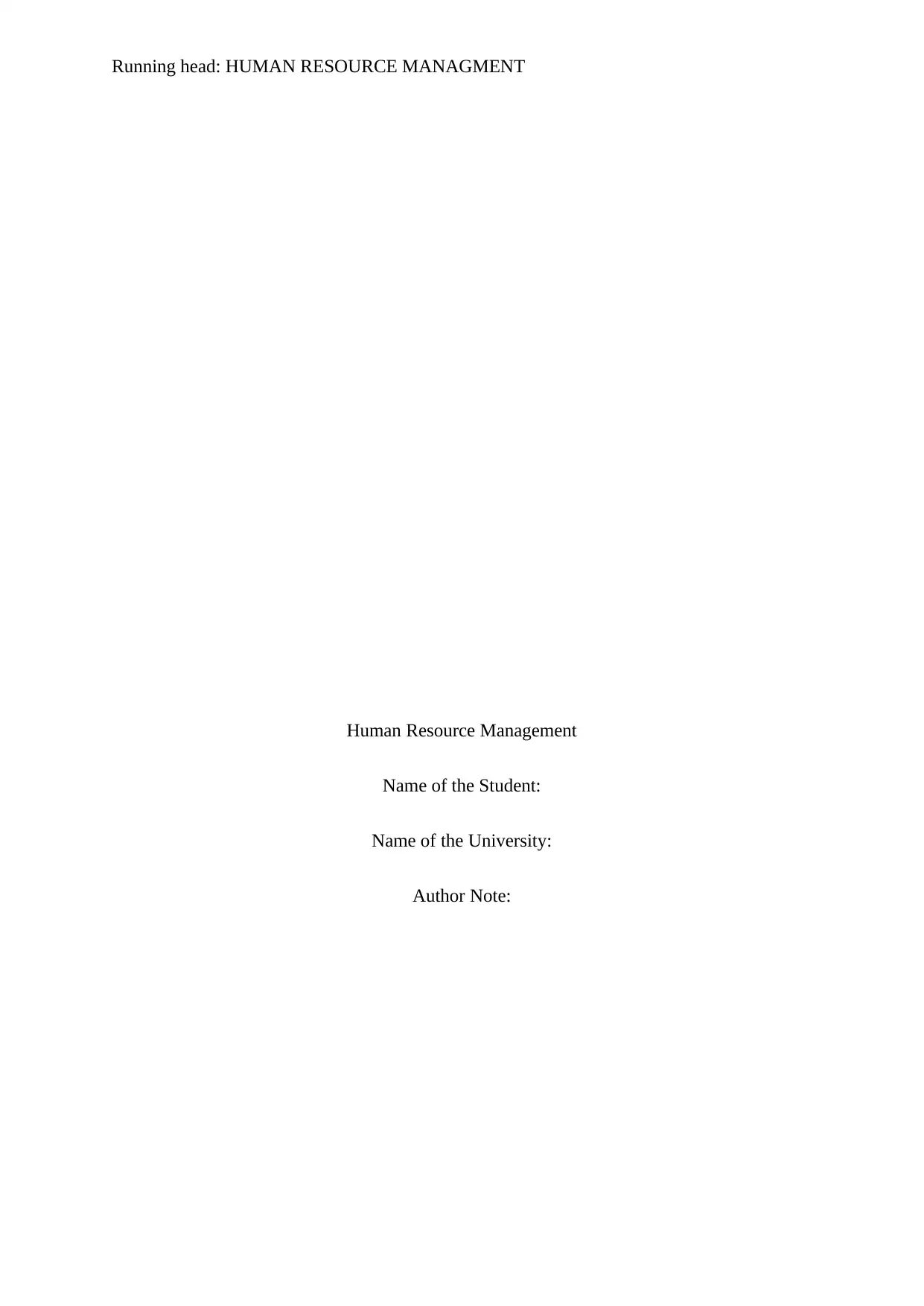
Running head: HUMAN RESOURCE MANAGMENT
Human Resource Management
Name of the Student:
Name of the University:
Author Note:
Human Resource Management
Name of the Student:
Name of the University:
Author Note:
Paraphrase This Document
Need a fresh take? Get an instant paraphrase of this document with our AI Paraphraser
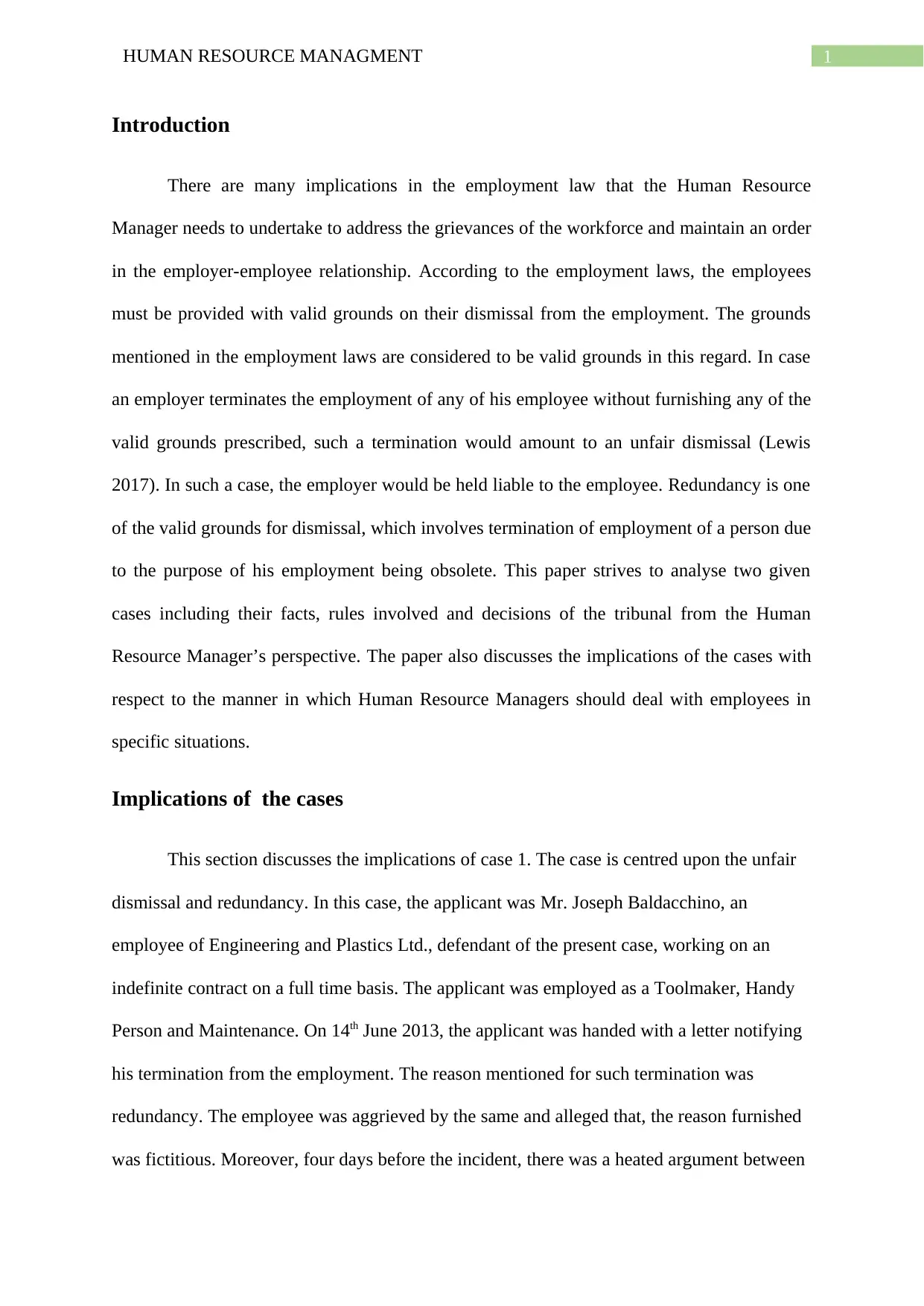
1HUMAN RESOURCE MANAGMENT
Introduction
There are many implications in the employment law that the Human Resource
Manager needs to undertake to address the grievances of the workforce and maintain an order
in the employer-employee relationship. According to the employment laws, the employees
must be provided with valid grounds on their dismissal from the employment. The grounds
mentioned in the employment laws are considered to be valid grounds in this regard. In case
an employer terminates the employment of any of his employee without furnishing any of the
valid grounds prescribed, such a termination would amount to an unfair dismissal (Lewis
2017). In such a case, the employer would be held liable to the employee. Redundancy is one
of the valid grounds for dismissal, which involves termination of employment of a person due
to the purpose of his employment being obsolete. This paper strives to analyse two given
cases including their facts, rules involved and decisions of the tribunal from the Human
Resource Manager’s perspective. The paper also discusses the implications of the cases with
respect to the manner in which Human Resource Managers should deal with employees in
specific situations.
Implications of the cases
This section discusses the implications of case 1. The case is centred upon the unfair
dismissal and redundancy. In this case, the applicant was Mr. Joseph Baldacchino, an
employee of Engineering and Plastics Ltd., defendant of the present case, working on an
indefinite contract on a full time basis. The applicant was employed as a Toolmaker, Handy
Person and Maintenance. On 14th June 2013, the applicant was handed with a letter notifying
his termination from the employment. The reason mentioned for such termination was
redundancy. The employee was aggrieved by the same and alleged that, the reason furnished
was fictitious. Moreover, four days before the incident, there was a heated argument between
Introduction
There are many implications in the employment law that the Human Resource
Manager needs to undertake to address the grievances of the workforce and maintain an order
in the employer-employee relationship. According to the employment laws, the employees
must be provided with valid grounds on their dismissal from the employment. The grounds
mentioned in the employment laws are considered to be valid grounds in this regard. In case
an employer terminates the employment of any of his employee without furnishing any of the
valid grounds prescribed, such a termination would amount to an unfair dismissal (Lewis
2017). In such a case, the employer would be held liable to the employee. Redundancy is one
of the valid grounds for dismissal, which involves termination of employment of a person due
to the purpose of his employment being obsolete. This paper strives to analyse two given
cases including their facts, rules involved and decisions of the tribunal from the Human
Resource Manager’s perspective. The paper also discusses the implications of the cases with
respect to the manner in which Human Resource Managers should deal with employees in
specific situations.
Implications of the cases
This section discusses the implications of case 1. The case is centred upon the unfair
dismissal and redundancy. In this case, the applicant was Mr. Joseph Baldacchino, an
employee of Engineering and Plastics Ltd., defendant of the present case, working on an
indefinite contract on a full time basis. The applicant was employed as a Toolmaker, Handy
Person and Maintenance. On 14th June 2013, the applicant was handed with a letter notifying
his termination from the employment. The reason mentioned for such termination was
redundancy. The employee was aggrieved by the same and alleged that, the reason furnished
was fictitious. Moreover, four days before the incident, there was a heated argument between
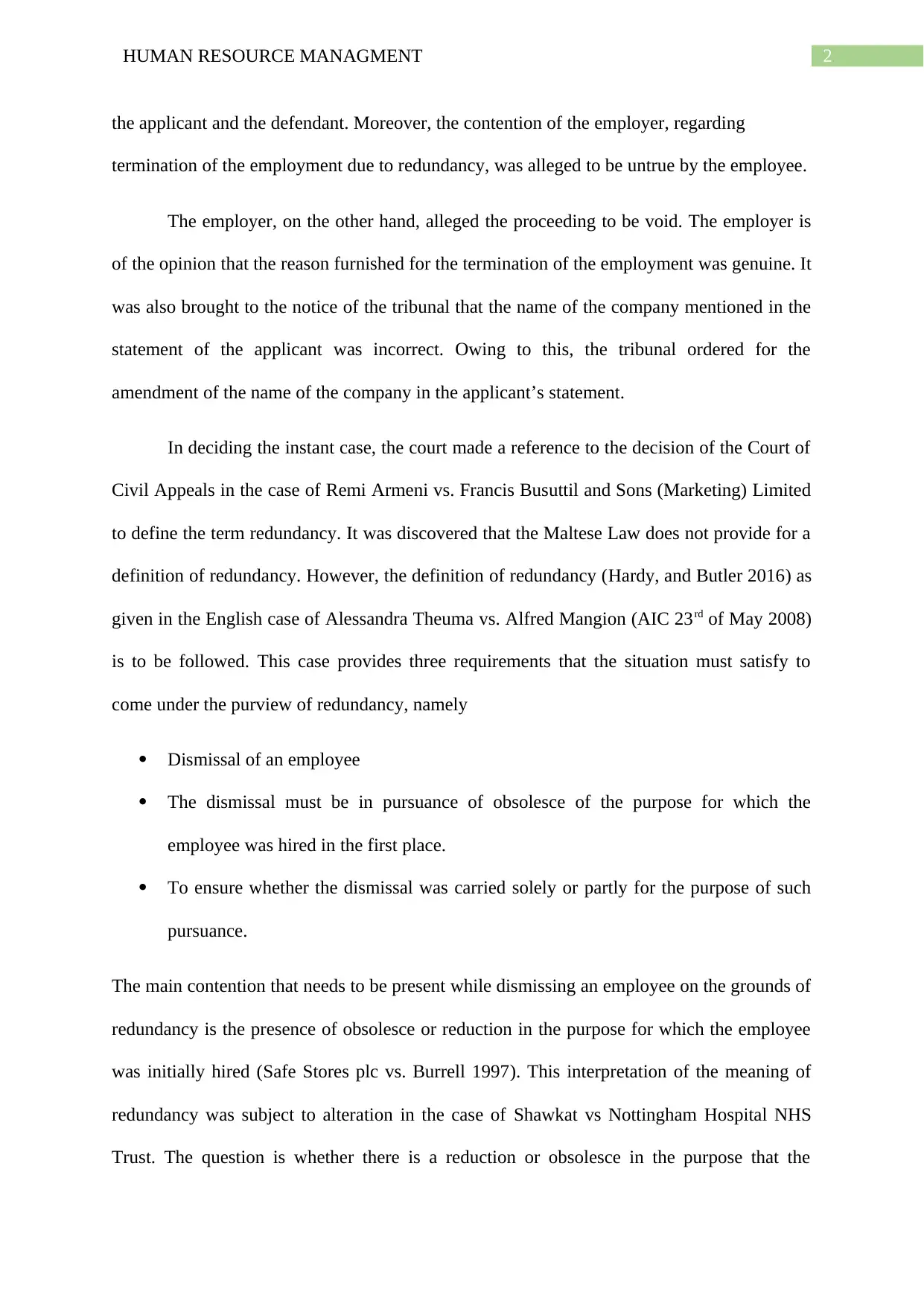
2HUMAN RESOURCE MANAGMENT
the applicant and the defendant. Moreover, the contention of the employer, regarding
termination of the employment due to redundancy, was alleged to be untrue by the employee.
The employer, on the other hand, alleged the proceeding to be void. The employer is
of the opinion that the reason furnished for the termination of the employment was genuine. It
was also brought to the notice of the tribunal that the name of the company mentioned in the
statement of the applicant was incorrect. Owing to this, the tribunal ordered for the
amendment of the name of the company in the applicant’s statement.
In deciding the instant case, the court made a reference to the decision of the Court of
Civil Appeals in the case of Remi Armeni vs. Francis Busuttil and Sons (Marketing) Limited
to define the term redundancy. It was discovered that the Maltese Law does not provide for a
definition of redundancy. However, the definition of redundancy (Hardy, and Butler 2016) as
given in the English case of Alessandra Theuma vs. Alfred Mangion (AIC 23rd of May 2008)
is to be followed. This case provides three requirements that the situation must satisfy to
come under the purview of redundancy, namely
Dismissal of an employee
The dismissal must be in pursuance of obsolesce of the purpose for which the
employee was hired in the first place.
To ensure whether the dismissal was carried solely or partly for the purpose of such
pursuance.
The main contention that needs to be present while dismissing an employee on the grounds of
redundancy is the presence of obsolesce or reduction in the purpose for which the employee
was initially hired (Safe Stores plc vs. Burrell 1997). This interpretation of the meaning of
redundancy was subject to alteration in the case of Shawkat vs Nottingham Hospital NHS
Trust. The question is whether there is a reduction or obsolesce in the purpose that the
the applicant and the defendant. Moreover, the contention of the employer, regarding
termination of the employment due to redundancy, was alleged to be untrue by the employee.
The employer, on the other hand, alleged the proceeding to be void. The employer is
of the opinion that the reason furnished for the termination of the employment was genuine. It
was also brought to the notice of the tribunal that the name of the company mentioned in the
statement of the applicant was incorrect. Owing to this, the tribunal ordered for the
amendment of the name of the company in the applicant’s statement.
In deciding the instant case, the court made a reference to the decision of the Court of
Civil Appeals in the case of Remi Armeni vs. Francis Busuttil and Sons (Marketing) Limited
to define the term redundancy. It was discovered that the Maltese Law does not provide for a
definition of redundancy. However, the definition of redundancy (Hardy, and Butler 2016) as
given in the English case of Alessandra Theuma vs. Alfred Mangion (AIC 23rd of May 2008)
is to be followed. This case provides three requirements that the situation must satisfy to
come under the purview of redundancy, namely
Dismissal of an employee
The dismissal must be in pursuance of obsolesce of the purpose for which the
employee was hired in the first place.
To ensure whether the dismissal was carried solely or partly for the purpose of such
pursuance.
The main contention that needs to be present while dismissing an employee on the grounds of
redundancy is the presence of obsolesce or reduction in the purpose for which the employee
was initially hired (Safe Stores plc vs. Burrell 1997). This interpretation of the meaning of
redundancy was subject to alteration in the case of Shawkat vs Nottingham Hospital NHS
Trust. The question is whether there is a reduction or obsolesce in the purpose that the
⊘ This is a preview!⊘
Do you want full access?
Subscribe today to unlock all pages.

Trusted by 1+ million students worldwide
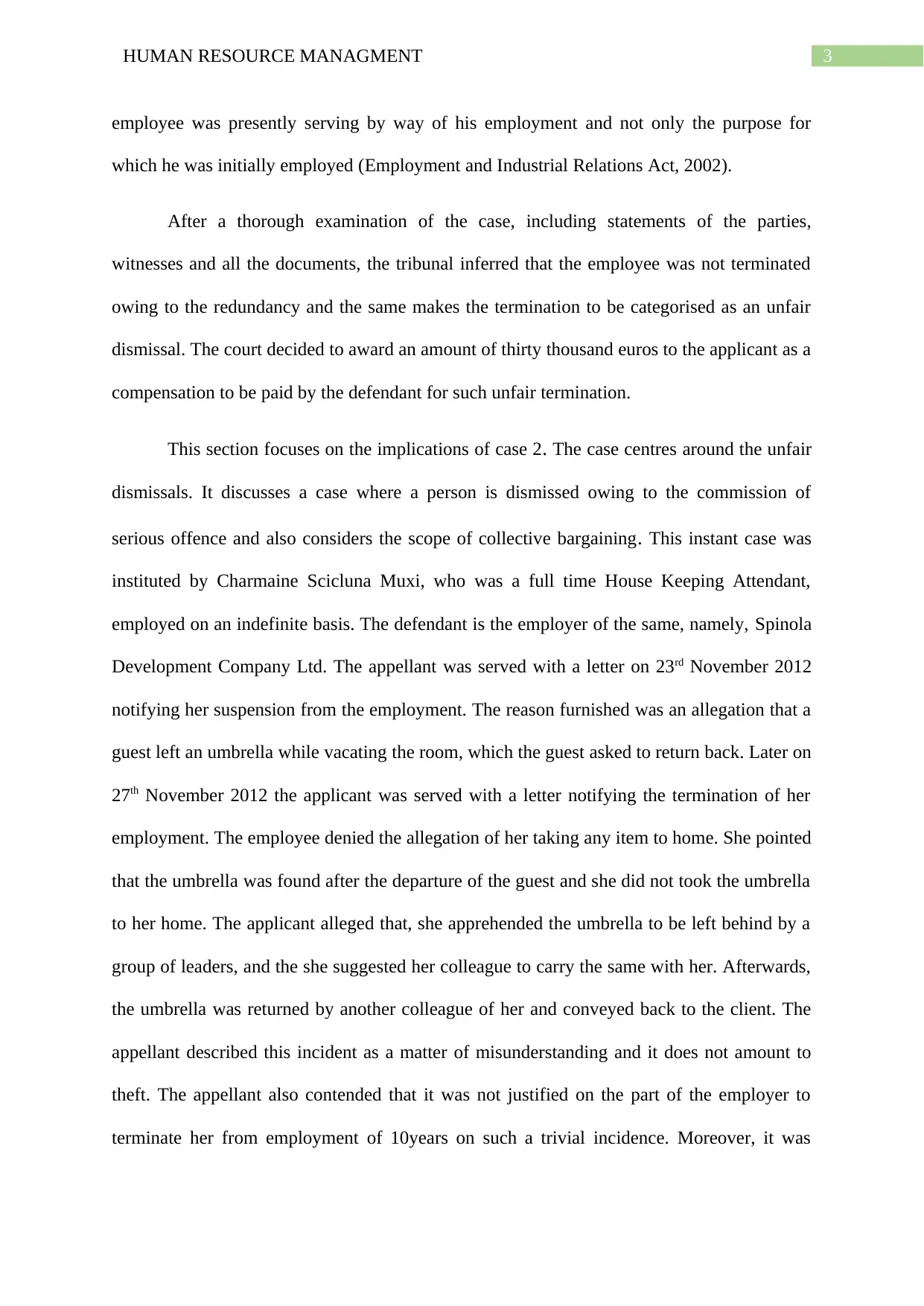
3HUMAN RESOURCE MANAGMENT
employee was presently serving by way of his employment and not only the purpose for
which he was initially employed (Employment and Industrial Relations Act, 2002).
After a thorough examination of the case, including statements of the parties,
witnesses and all the documents, the tribunal inferred that the employee was not terminated
owing to the redundancy and the same makes the termination to be categorised as an unfair
dismissal. The court decided to award an amount of thirty thousand euros to the applicant as a
compensation to be paid by the defendant for such unfair termination.
This section focuses on the implications of case 2. The case centres around the unfair
dismissals. It discusses a case where a person is dismissed owing to the commission of
serious offence and also considers the scope of collective bargaining. This instant case was
instituted by Charmaine Scicluna Muxi, who was a full time House Keeping Attendant,
employed on an indefinite basis. The defendant is the employer of the same, namely, Spinola
Development Company Ltd. The appellant was served with a letter on 23rd November 2012
notifying her suspension from the employment. The reason furnished was an allegation that a
guest left an umbrella while vacating the room, which the guest asked to return back. Later on
27th November 2012 the applicant was served with a letter notifying the termination of her
employment. The employee denied the allegation of her taking any item to home. She pointed
that the umbrella was found after the departure of the guest and she did not took the umbrella
to her home. The applicant alleged that, she apprehended the umbrella to be left behind by a
group of leaders, and the she suggested her colleague to carry the same with her. Afterwards,
the umbrella was returned by another colleague of her and conveyed back to the client. The
appellant described this incident as a matter of misunderstanding and it does not amount to
theft. The appellant also contended that it was not justified on the part of the employer to
terminate her from employment of 10years on such a trivial incidence. Moreover, it was
employee was presently serving by way of his employment and not only the purpose for
which he was initially employed (Employment and Industrial Relations Act, 2002).
After a thorough examination of the case, including statements of the parties,
witnesses and all the documents, the tribunal inferred that the employee was not terminated
owing to the redundancy and the same makes the termination to be categorised as an unfair
dismissal. The court decided to award an amount of thirty thousand euros to the applicant as a
compensation to be paid by the defendant for such unfair termination.
This section focuses on the implications of case 2. The case centres around the unfair
dismissals. It discusses a case where a person is dismissed owing to the commission of
serious offence and also considers the scope of collective bargaining. This instant case was
instituted by Charmaine Scicluna Muxi, who was a full time House Keeping Attendant,
employed on an indefinite basis. The defendant is the employer of the same, namely, Spinola
Development Company Ltd. The appellant was served with a letter on 23rd November 2012
notifying her suspension from the employment. The reason furnished was an allegation that a
guest left an umbrella while vacating the room, which the guest asked to return back. Later on
27th November 2012 the applicant was served with a letter notifying the termination of her
employment. The employee denied the allegation of her taking any item to home. She pointed
that the umbrella was found after the departure of the guest and she did not took the umbrella
to her home. The applicant alleged that, she apprehended the umbrella to be left behind by a
group of leaders, and the she suggested her colleague to carry the same with her. Afterwards,
the umbrella was returned by another colleague of her and conveyed back to the client. The
appellant described this incident as a matter of misunderstanding and it does not amount to
theft. The appellant also contended that it was not justified on the part of the employer to
terminate her from employment of 10years on such a trivial incidence. Moreover, it was
Paraphrase This Document
Need a fresh take? Get an instant paraphrase of this document with our AI Paraphraser
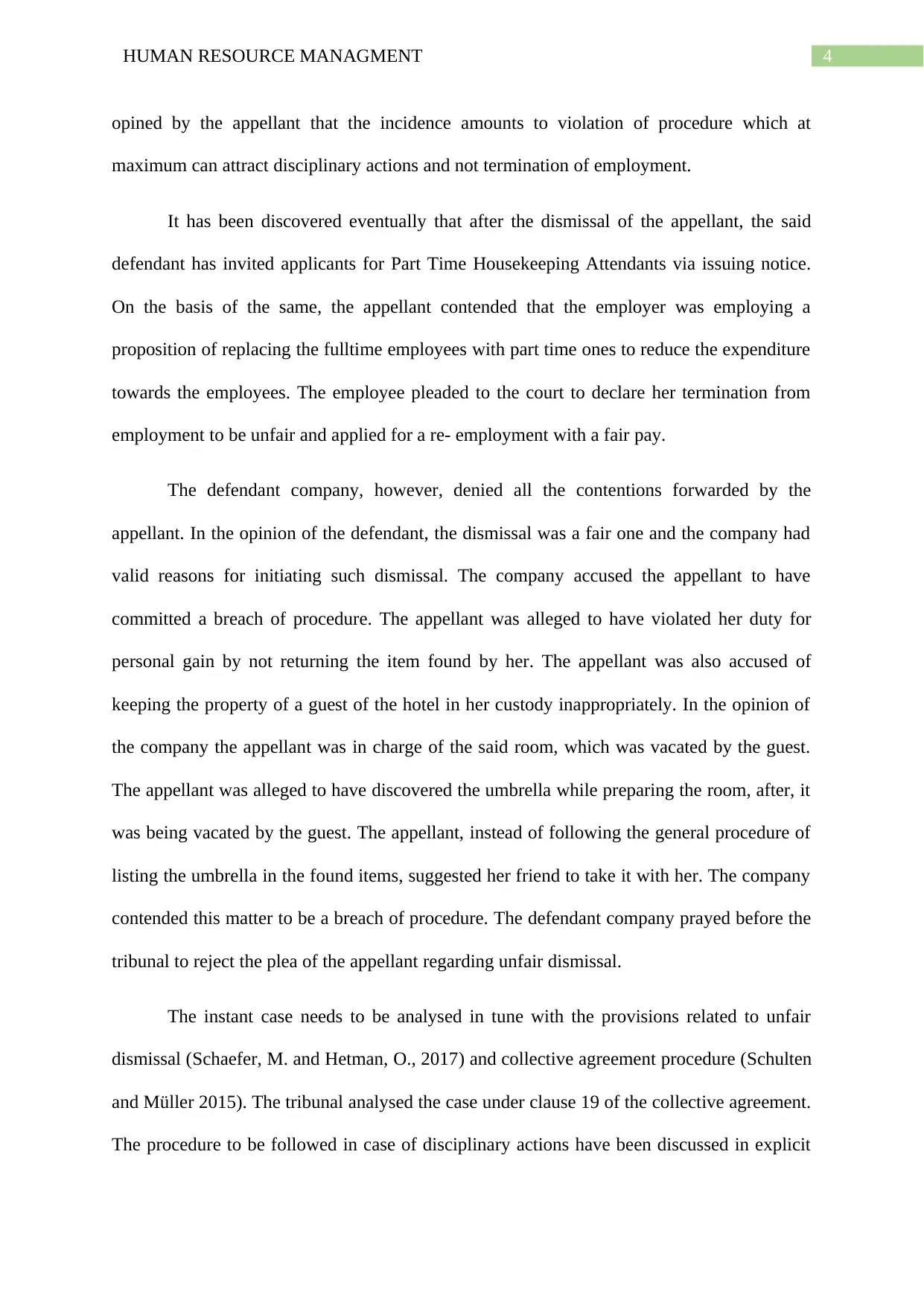
4HUMAN RESOURCE MANAGMENT
opined by the appellant that the incidence amounts to violation of procedure which at
maximum can attract disciplinary actions and not termination of employment.
It has been discovered eventually that after the dismissal of the appellant, the said
defendant has invited applicants for Part Time Housekeeping Attendants via issuing notice.
On the basis of the same, the appellant contended that the employer was employing a
proposition of replacing the fulltime employees with part time ones to reduce the expenditure
towards the employees. The employee pleaded to the court to declare her termination from
employment to be unfair and applied for a re- employment with a fair pay.
The defendant company, however, denied all the contentions forwarded by the
appellant. In the opinion of the defendant, the dismissal was a fair one and the company had
valid reasons for initiating such dismissal. The company accused the appellant to have
committed a breach of procedure. The appellant was alleged to have violated her duty for
personal gain by not returning the item found by her. The appellant was also accused of
keeping the property of a guest of the hotel in her custody inappropriately. In the opinion of
the company the appellant was in charge of the said room, which was vacated by the guest.
The appellant was alleged to have discovered the umbrella while preparing the room, after, it
was being vacated by the guest. The appellant, instead of following the general procedure of
listing the umbrella in the found items, suggested her friend to take it with her. The company
contended this matter to be a breach of procedure. The defendant company prayed before the
tribunal to reject the plea of the appellant regarding unfair dismissal.
The instant case needs to be analysed in tune with the provisions related to unfair
dismissal (Schaefer, M. and Hetman, O., 2017) and collective agreement procedure (Schulten
and Müller 2015). The tribunal analysed the case under clause 19 of the collective agreement.
The procedure to be followed in case of disciplinary actions have been discussed in explicit
opined by the appellant that the incidence amounts to violation of procedure which at
maximum can attract disciplinary actions and not termination of employment.
It has been discovered eventually that after the dismissal of the appellant, the said
defendant has invited applicants for Part Time Housekeeping Attendants via issuing notice.
On the basis of the same, the appellant contended that the employer was employing a
proposition of replacing the fulltime employees with part time ones to reduce the expenditure
towards the employees. The employee pleaded to the court to declare her termination from
employment to be unfair and applied for a re- employment with a fair pay.
The defendant company, however, denied all the contentions forwarded by the
appellant. In the opinion of the defendant, the dismissal was a fair one and the company had
valid reasons for initiating such dismissal. The company accused the appellant to have
committed a breach of procedure. The appellant was alleged to have violated her duty for
personal gain by not returning the item found by her. The appellant was also accused of
keeping the property of a guest of the hotel in her custody inappropriately. In the opinion of
the company the appellant was in charge of the said room, which was vacated by the guest.
The appellant was alleged to have discovered the umbrella while preparing the room, after, it
was being vacated by the guest. The appellant, instead of following the general procedure of
listing the umbrella in the found items, suggested her friend to take it with her. The company
contended this matter to be a breach of procedure. The defendant company prayed before the
tribunal to reject the plea of the appellant regarding unfair dismissal.
The instant case needs to be analysed in tune with the provisions related to unfair
dismissal (Schaefer, M. and Hetman, O., 2017) and collective agreement procedure (Schulten
and Müller 2015). The tribunal analysed the case under clause 19 of the collective agreement.
The procedure to be followed in case of disciplinary actions have been discussed in explicit
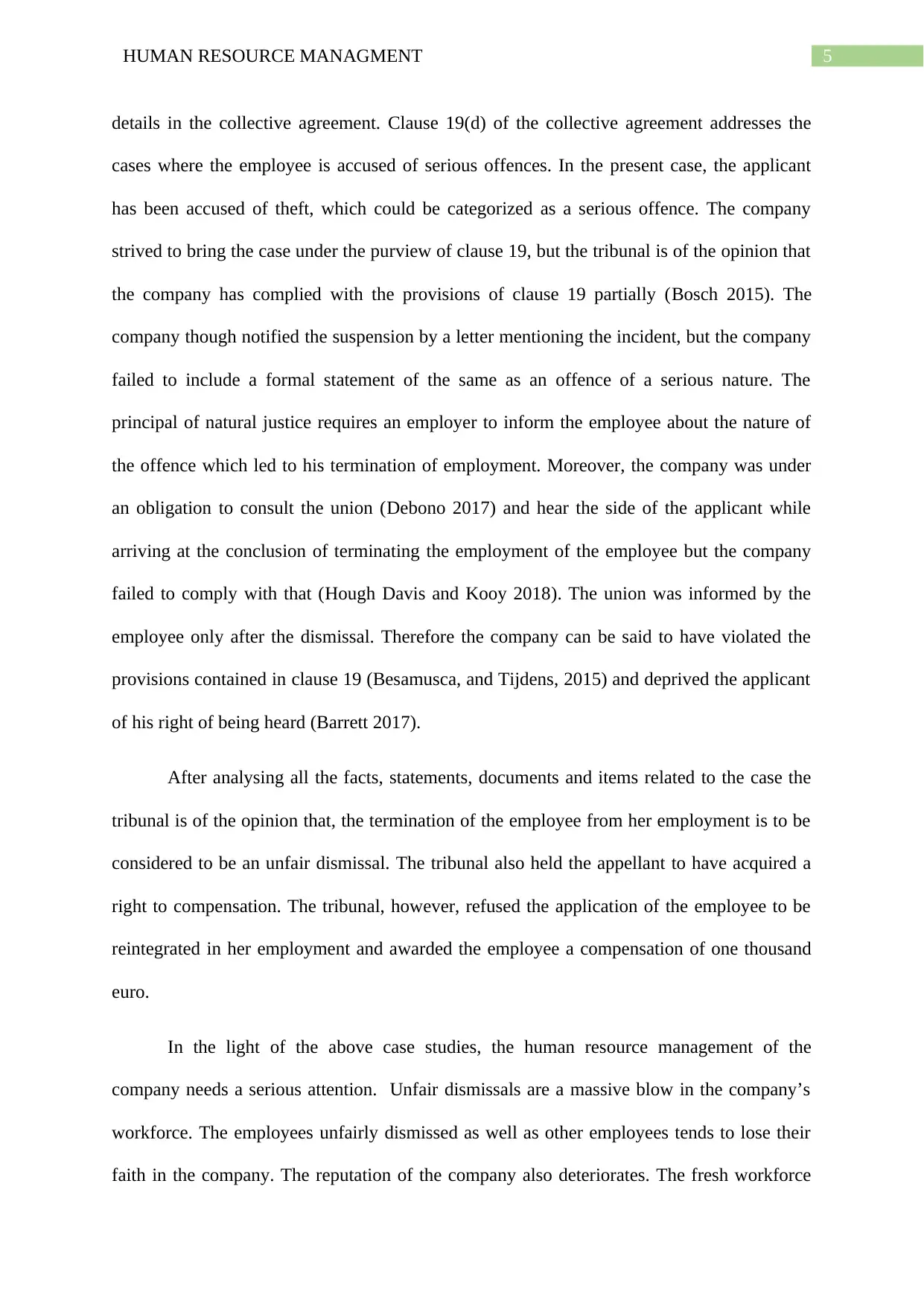
5HUMAN RESOURCE MANAGMENT
details in the collective agreement. Clause 19(d) of the collective agreement addresses the
cases where the employee is accused of serious offences. In the present case, the applicant
has been accused of theft, which could be categorized as a serious offence. The company
strived to bring the case under the purview of clause 19, but the tribunal is of the opinion that
the company has complied with the provisions of clause 19 partially (Bosch 2015). The
company though notified the suspension by a letter mentioning the incident, but the company
failed to include a formal statement of the same as an offence of a serious nature. The
principal of natural justice requires an employer to inform the employee about the nature of
the offence which led to his termination of employment. Moreover, the company was under
an obligation to consult the union (Debono 2017) and hear the side of the applicant while
arriving at the conclusion of terminating the employment of the employee but the company
failed to comply with that (Hough Davis and Kooy 2018). The union was informed by the
employee only after the dismissal. Therefore the company can be said to have violated the
provisions contained in clause 19 (Besamusca, and Tijdens, 2015) and deprived the applicant
of his right of being heard (Barrett 2017).
After analysing all the facts, statements, documents and items related to the case the
tribunal is of the opinion that, the termination of the employee from her employment is to be
considered to be an unfair dismissal. The tribunal also held the appellant to have acquired a
right to compensation. The tribunal, however, refused the application of the employee to be
reintegrated in her employment and awarded the employee a compensation of one thousand
euro.
In the light of the above case studies, the human resource management of the
company needs a serious attention. Unfair dismissals are a massive blow in the company’s
workforce. The employees unfairly dismissed as well as other employees tends to lose their
faith in the company. The reputation of the company also deteriorates. The fresh workforce
details in the collective agreement. Clause 19(d) of the collective agreement addresses the
cases where the employee is accused of serious offences. In the present case, the applicant
has been accused of theft, which could be categorized as a serious offence. The company
strived to bring the case under the purview of clause 19, but the tribunal is of the opinion that
the company has complied with the provisions of clause 19 partially (Bosch 2015). The
company though notified the suspension by a letter mentioning the incident, but the company
failed to include a formal statement of the same as an offence of a serious nature. The
principal of natural justice requires an employer to inform the employee about the nature of
the offence which led to his termination of employment. Moreover, the company was under
an obligation to consult the union (Debono 2017) and hear the side of the applicant while
arriving at the conclusion of terminating the employment of the employee but the company
failed to comply with that (Hough Davis and Kooy 2018). The union was informed by the
employee only after the dismissal. Therefore the company can be said to have violated the
provisions contained in clause 19 (Besamusca, and Tijdens, 2015) and deprived the applicant
of his right of being heard (Barrett 2017).
After analysing all the facts, statements, documents and items related to the case the
tribunal is of the opinion that, the termination of the employee from her employment is to be
considered to be an unfair dismissal. The tribunal also held the appellant to have acquired a
right to compensation. The tribunal, however, refused the application of the employee to be
reintegrated in her employment and awarded the employee a compensation of one thousand
euro.
In the light of the above case studies, the human resource management of the
company needs a serious attention. Unfair dismissals are a massive blow in the company’s
workforce. The employees unfairly dismissed as well as other employees tends to lose their
faith in the company. The reputation of the company also deteriorates. The fresh workforce
⊘ This is a preview!⊘
Do you want full access?
Subscribe today to unlock all pages.

Trusted by 1+ million students worldwide
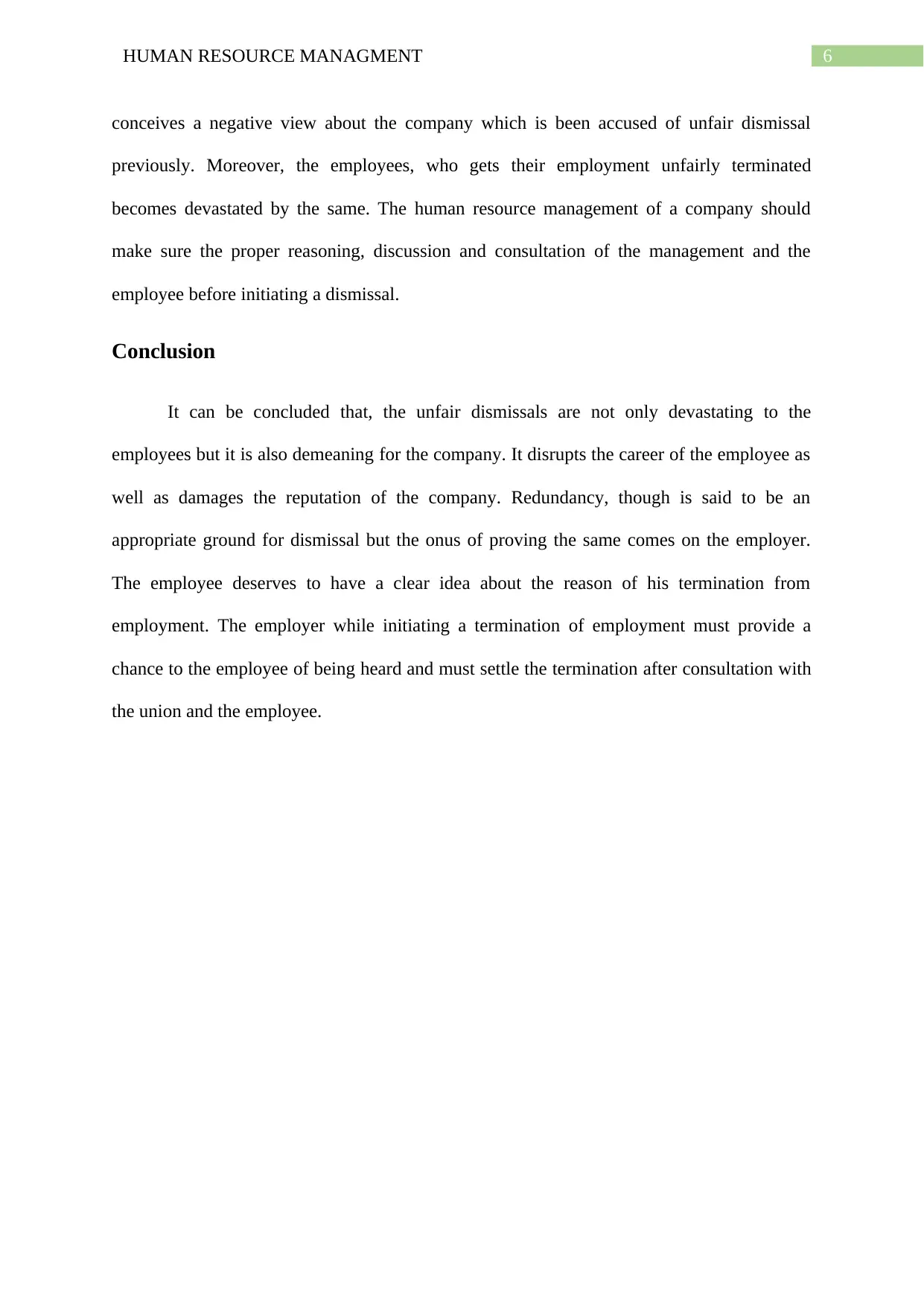
6HUMAN RESOURCE MANAGMENT
conceives a negative view about the company which is been accused of unfair dismissal
previously. Moreover, the employees, who gets their employment unfairly terminated
becomes devastated by the same. The human resource management of a company should
make sure the proper reasoning, discussion and consultation of the management and the
employee before initiating a dismissal.
Conclusion
It can be concluded that, the unfair dismissals are not only devastating to the
employees but it is also demeaning for the company. It disrupts the career of the employee as
well as damages the reputation of the company. Redundancy, though is said to be an
appropriate ground for dismissal but the onus of proving the same comes on the employer.
The employee deserves to have a clear idea about the reason of his termination from
employment. The employer while initiating a termination of employment must provide a
chance to the employee of being heard and must settle the termination after consultation with
the union and the employee.
conceives a negative view about the company which is been accused of unfair dismissal
previously. Moreover, the employees, who gets their employment unfairly terminated
becomes devastated by the same. The human resource management of a company should
make sure the proper reasoning, discussion and consultation of the management and the
employee before initiating a dismissal.
Conclusion
It can be concluded that, the unfair dismissals are not only devastating to the
employees but it is also demeaning for the company. It disrupts the career of the employee as
well as damages the reputation of the company. Redundancy, though is said to be an
appropriate ground for dismissal but the onus of proving the same comes on the employer.
The employee deserves to have a clear idea about the reason of his termination from
employment. The employer while initiating a termination of employment must provide a
chance to the employee of being heard and must settle the termination after consultation with
the union and the employee.
Paraphrase This Document
Need a fresh take? Get an instant paraphrase of this document with our AI Paraphraser
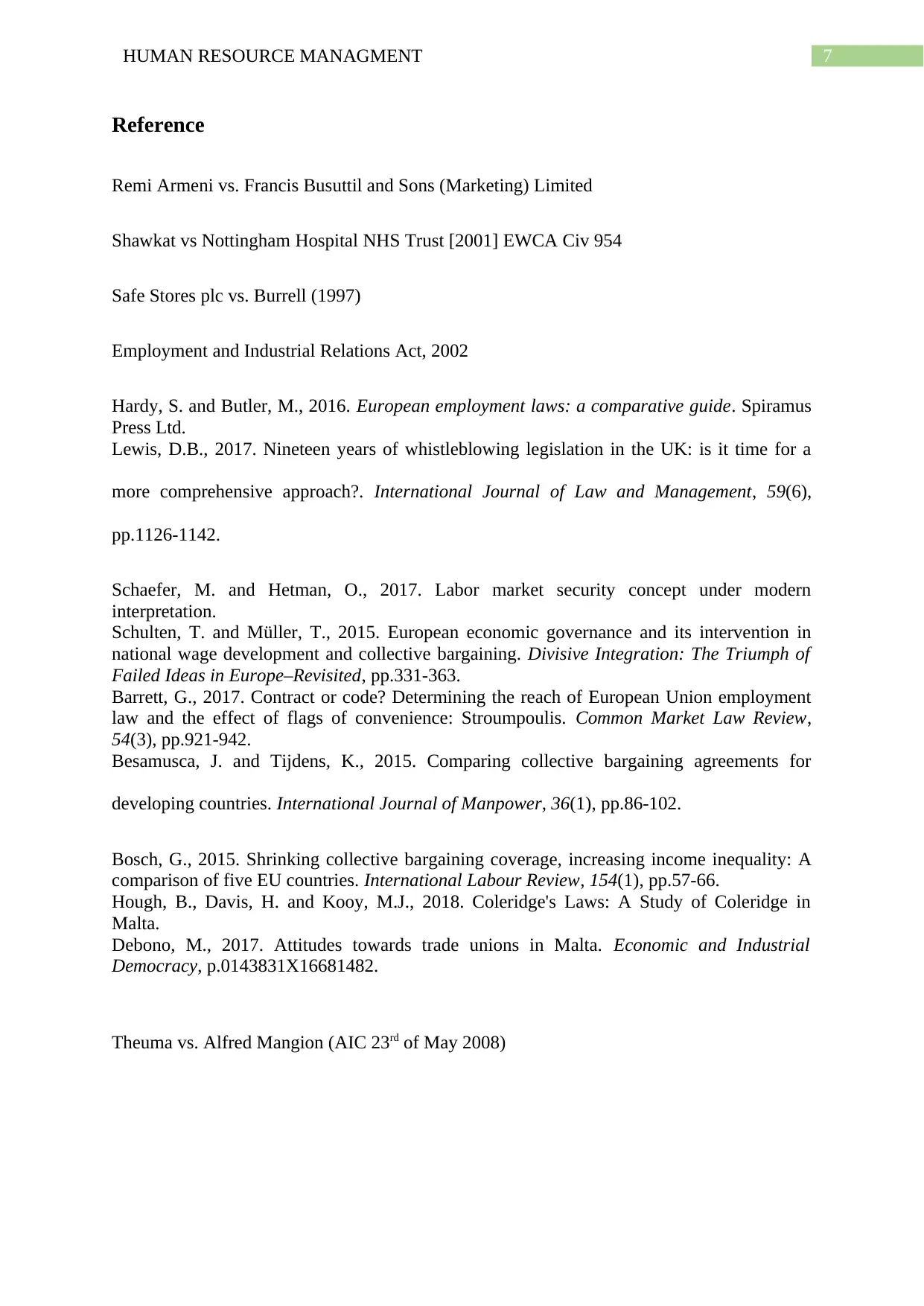
7HUMAN RESOURCE MANAGMENT
Reference
Remi Armeni vs. Francis Busuttil and Sons (Marketing) Limited
Shawkat vs Nottingham Hospital NHS Trust [2001] EWCA Civ 954
Safe Stores plc vs. Burrell (1997)
Employment and Industrial Relations Act, 2002
Hardy, S. and Butler, M., 2016. European employment laws: a comparative guide. Spiramus
Press Ltd.
Lewis, D.B., 2017. Nineteen years of whistleblowing legislation in the UK: is it time for a
more comprehensive approach?. International Journal of Law and Management, 59(6),
pp.1126-1142.
Schaefer, M. and Hetman, O., 2017. Labor market security concept under modern
interpretation.
Schulten, T. and Müller, T., 2015. European economic governance and its intervention in
national wage development and collective bargaining. Divisive Integration: The Triumph of
Failed Ideas in Europe–Revisited, pp.331-363.
Barrett, G., 2017. Contract or code? Determining the reach of European Union employment
law and the effect of flags of convenience: Stroumpoulis. Common Market Law Review,
54(3), pp.921-942.
Besamusca, J. and Tijdens, K., 2015. Comparing collective bargaining agreements for
developing countries. International Journal of Manpower, 36(1), pp.86-102.
Bosch, G., 2015. Shrinking collective bargaining coverage, increasing income inequality: A
comparison of five EU countries. International Labour Review, 154(1), pp.57-66.
Hough, B., Davis, H. and Kooy, M.J., 2018. Coleridge's Laws: A Study of Coleridge in
Malta.
Debono, M., 2017. Attitudes towards trade unions in Malta. Economic and Industrial
Democracy, p.0143831X16681482.
Theuma vs. Alfred Mangion (AIC 23rd of May 2008)
Reference
Remi Armeni vs. Francis Busuttil and Sons (Marketing) Limited
Shawkat vs Nottingham Hospital NHS Trust [2001] EWCA Civ 954
Safe Stores plc vs. Burrell (1997)
Employment and Industrial Relations Act, 2002
Hardy, S. and Butler, M., 2016. European employment laws: a comparative guide. Spiramus
Press Ltd.
Lewis, D.B., 2017. Nineteen years of whistleblowing legislation in the UK: is it time for a
more comprehensive approach?. International Journal of Law and Management, 59(6),
pp.1126-1142.
Schaefer, M. and Hetman, O., 2017. Labor market security concept under modern
interpretation.
Schulten, T. and Müller, T., 2015. European economic governance and its intervention in
national wage development and collective bargaining. Divisive Integration: The Triumph of
Failed Ideas in Europe–Revisited, pp.331-363.
Barrett, G., 2017. Contract or code? Determining the reach of European Union employment
law and the effect of flags of convenience: Stroumpoulis. Common Market Law Review,
54(3), pp.921-942.
Besamusca, J. and Tijdens, K., 2015. Comparing collective bargaining agreements for
developing countries. International Journal of Manpower, 36(1), pp.86-102.
Bosch, G., 2015. Shrinking collective bargaining coverage, increasing income inequality: A
comparison of five EU countries. International Labour Review, 154(1), pp.57-66.
Hough, B., Davis, H. and Kooy, M.J., 2018. Coleridge's Laws: A Study of Coleridge in
Malta.
Debono, M., 2017. Attitudes towards trade unions in Malta. Economic and Industrial
Democracy, p.0143831X16681482.
Theuma vs. Alfred Mangion (AIC 23rd of May 2008)
1 out of 8
Related Documents
Your All-in-One AI-Powered Toolkit for Academic Success.
+13062052269
info@desklib.com
Available 24*7 on WhatsApp / Email
![[object Object]](/_next/static/media/star-bottom.7253800d.svg)
Unlock your academic potential
Copyright © 2020–2025 A2Z Services. All Rights Reserved. Developed and managed by ZUCOL.





